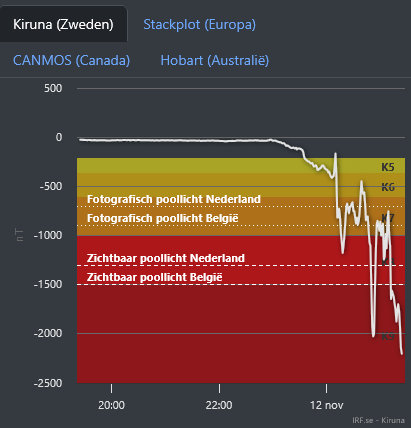WKN Weer, Klimaat en Natuurrampen
Lees alles over het onstuimige weer op onze planeet, volg orkanen en tornado's, zie hoe vulkanen uitbarsten en hoe Moeder Aarde beeft bij een aardbeving. Alles over de verwoestende kracht van onze planeet en tal van andere natuurverschijnselen.



Ik had ff gespiekt rond 2.10 maar helaas toen nog niets..begreep een uur later wel  jammerrrr
jammerrrr
[b]Hobbelicious is back!
[/b]
[/b]


Bekijk deze YouTube-video
quote:Major X1.9 solar flare erupts from AR 4299, producing partial halo CME
A major solar flare registered as X1.9 erupted from Active Region 4299 at 02:49 UTC on December 1, 2025. The event started at 02:27 and ended at 03:05 UTC. This region is currently making its second run through the Earth-side of the Sun, after producing multiple X-class flares in early November.
A Type II Radio Emission with an estimated velocity of 988 km/s was registered at 02:43 UTC, indicating a coronal mass ejection (CME) was associated with the event.
Active Region 4299 is located on the Sun’s northeastern limb, limiting the possibility for Earth-directed CMEs. However, this will change as the week progresses, and the region moves toward a geoeffective position.
This is the old Region 4274, source of multiple X-class flares during its last rotation over the Earth-side in early November, including X5.1 on November 11, which produced the strongest Ground Level Enhancement event in 20 years.
Other notable flares from this region include X4.0 on November 14, X1.7 on November 9, and X1.2 on November 10.
Radio frequencies were forecast to be most degraded over Australia at the time of the flare event.
“This storm is not Earth-directed (it is directed towards Saturn), but I would not be surprised if we see a radiation storm rise at Earth over the next few hours,” Space Weather Physicist Dr. Tamitha Skov said.
“Preliminary analysis of the recent X1.95-flare shows radio bursts of over 1.2 GHz observed at the new Wairakei SIGN station in New Zealand,” Skov said.
“This means this region has the potential to temporarily disrupt GPS/GNSS, satellite phone, and ADS-B airline transponder communications when it flares! Stay vigilant if you use these services while on the dayside of Earth!”
|
|

